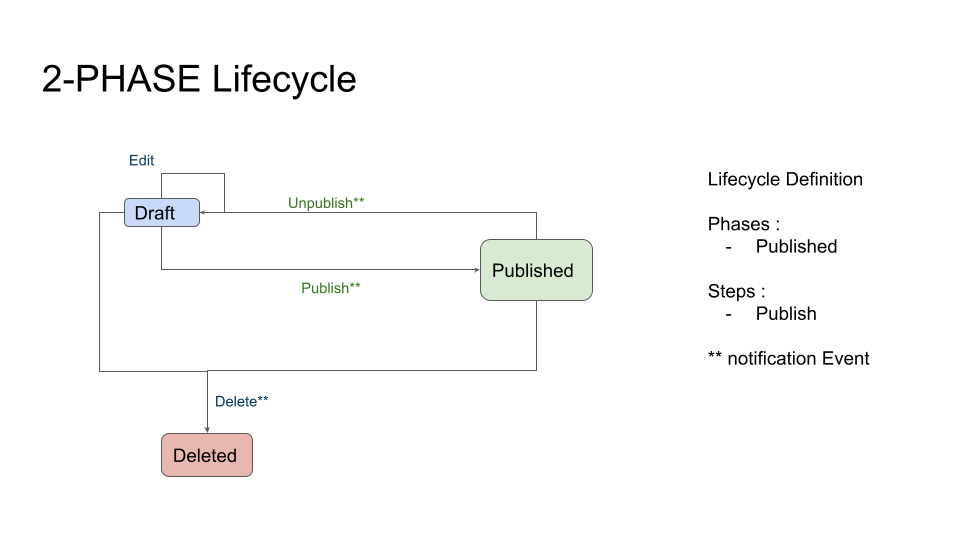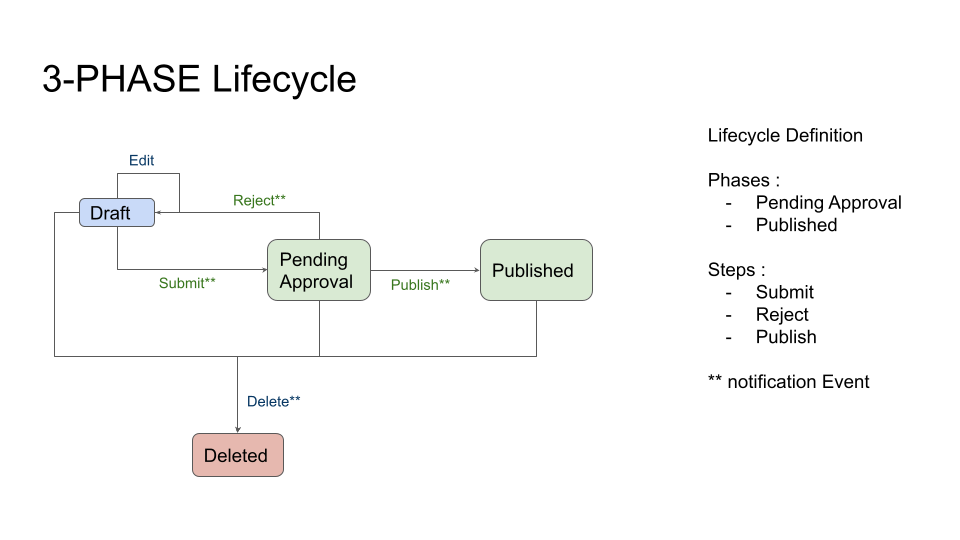5.0 KiB
Project Management (Lifecycle)
Note
You can experiment with the service by following the quickstart.
From creation to its publication/deletion, documents pass through
various PHASES of their life. These PHASES
define what operations (called STEPS) can be performed with
the project, being them automatic or human-driven (e.g.
moderated review). When invoked, operations may trigger collateral
EVENTS (e.g. ON_EDIT). The result of all these
operations may change the nature of the target
project, which contains a specific report for this (see
lifecycle)
Note
In brief : STEPS are operations that can be invoked by
callers, EVENTS are collateral operations.
Projects lifecycle can vary depending on the
configuration declared in its related ucd. However they may change, each
project lifecycle starts from the predefined
PHASE = DRAFT; what comes after that, depends on the
configured lifecycle.

In the figure above is represented a 2-PHASES lifecycle. In green, STEPS and PHASES defined by the lifecycle itself. In blue are re, the common operations Edit, Delete and the DRAFT PHASE. In red the DELETE PHASE (which isn't material).
Common Lifecycles
The suite comes with a pre-built set of implemented lifecycles with their STEPS, EVENTS and PHASES.
2 - Phases Lifecycle

TBD : steps phases, involved events
3 - Phases Lifecycle

TBD : steps phases, involved events
*************** Operation on
documents*************** .. note:: You can experiment with the
service API by following the quickstart.
Warning
Read and write permissions on projects are defined in ucd
While projects lifecycle can vary depending on the
configuration declared in its related ucd, following operations are common and available for
every project.
Basic operations
- Create New : The starting operation of every project. It
expects a JSON metadata document, which will constitute the
documentsection of the project. - Edit : Allows for the replacement of
document. - Delete : Deletes the specified project
- List / get by Id : allows access to projects.
Querying
Querying allows for the filtered access of subsets of projects. The following options are allowed in query operations
Note
Query engine is supported by MongoDB and exploits its query language. Check it out to learn more about it.
- filter : condition by witch to select returned projects
- ordering : field set and direction
- paging : limit and offset
- projection : projects fields selection to return in result
Registering / Unregistering FileSets
filesets are sets of
files representing a single entity, which need to be handled together
(e.g. a dataset and its index, a file and its crc).
Each filesets is
(un)registered at a particular path of the document with requests with
the following information :
Warning
Filesets fields need to be defined in ucd in order to be registered.
- field Name : fileset target field name
- parent path : the path of the target parent for the fileset
- field Definition path : the path of the field definition inside schema
- streams : url or gCube storage Volatile IDs of payloads and related filenames
{
"fieldDefinitionPath":"$.section._children[?(@.fileset)]",
"parentPath":"$.section",
"fieldName":"fileset",
"streams":[{"url":"https://www.cnr.it/sites/all/themes/custom/cnr03_theme/img/cnrlogo.svg","filename":"myLogo.svg"}]
}Note
Note that paths can be explicit or express a query. Refer to jsonpath lib.
Warning
Paths are required to match a single field for fileset registration.
Executing STEPS
In order to expose a common API while serving varying / customizable possible scenarios, the service expose only a single method for STEP execution.
The method perform STEP allows for the execution of the configured STEPs by serving requests with the following information:
- STEP ID : must be supported by the configured lifecycle
- options [optional]: a JSON document with all expected parameters for the execution of the specified STEP
Note
Outcome of STEPS and operations is reported in :ref`lifecycle` section of the project.
Steps execution may trigger EVENTS and sometimes other automatic STEPS. The following represents how this behaviour is implemented.
